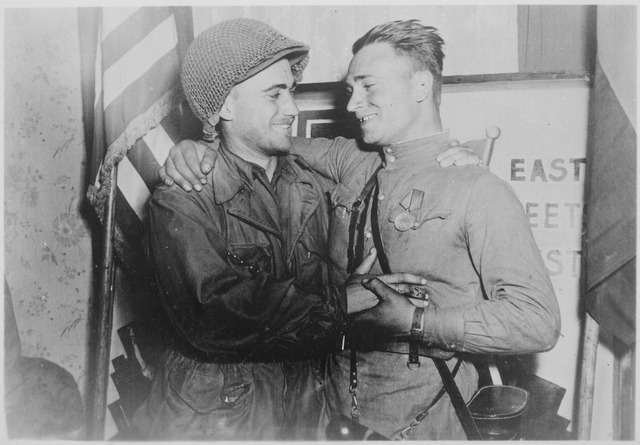In late April 1945, Joe Polowsky was about to be part of a historic event that is at a crossroads of the 20th century. It would change his life forever. It was the first encounter of American and Soviet troops in Nazi Germany, the meeting at Torgau.
During Spring of 1945 allied forces were on their way to bring the war with Nazi Germany to an end. British and American troops crossed the Rhine, captured the Frankfurt area, were victorious in the Ruhr pocket and the Red Army advanced through Poland and Silesia. Sooner or later the allied armies would meet somewhere in Germany.
Joe Polowsky was part of a unit that made a thrust through Eastern Germany, bypassing strongholds like the Harz Mountains and cities as Erfurt and Leipzig. On 24. April they were not far away from the Elbe river, which was agreed as a line to meet with the Soviets. They were anxious to meet the Red Army. It would be a sure sign that the war would come to an end. On the other hand no one wanted misunderstandings in a situation where sporadic, intense fighting against German pockets could happen anytime. It was decided to send a forward patrol to scout the area for the Soviets and Polowsky was part of it since he spoke German.
On the next day, the 25. April, they reached the Elbe near Strehla and spotted Soviet soldiers on the other bank. They signaled, fetched a boat and crossed the river.
Now, fighting soldiers of this unlikely alliance of the Second World War met for the first time. These two super powers with contradicting ideologies only chose to cooperate to survive the onslaught of Nazi Germany and Japan. The Americans were in Germany to relief the Red Army, who took the brunt of fighting the Wehrmacht. The second front, opened with the Normandy landings almost a year ago, led to victory.
The meeting could hardly be more symbolical. When the patrol with Polowsky left the boat on the Eastern bank of the Elbe river they met the Soviet soldiers among the bodies of hundreds of German civilians. Most of them were refugees fleeing the Red Army. They wanted to cross the river on a pontoon bridge, which was destroyed by German troops while it was shelled by Soviet artillery.
The officers had a sense that their meeting would be a historic event and decided that the place was not adequate. They arranged for a meeting later that day at Torgau some 20 km away. No official note was made of their encounter. Joe Polowsky however was moved by the event. He gave an oath to work to prevent such a war in the future.
The planned meeting at Torgau was announced as the official encounter. It had also to be reenacted two days later, with film cameras and journalists on location. The handshake picture of smiling soldiers was a powerful symbol for the end of the war. Two weeks later on 8. May 1945, Nazi Germany surrendered.

Joe Polowsky stayed true to his oath. Released from army service, he started to promote American-Soviet friendship and peace. He petitioned the newly founded UN to establish the 25.April as a World Peace Day. The rejection did not discourage him and he continued to lobby for peace during the Cold War: His views were seen as un-American during the McCarthy era, he was invited to Moscow and Eastern Germany by communist leaders and he was buried in Torgau during the Cold War in 1983 following his will.
Then sign up for our free email newsletter to get all our new posts right to your inbox.
